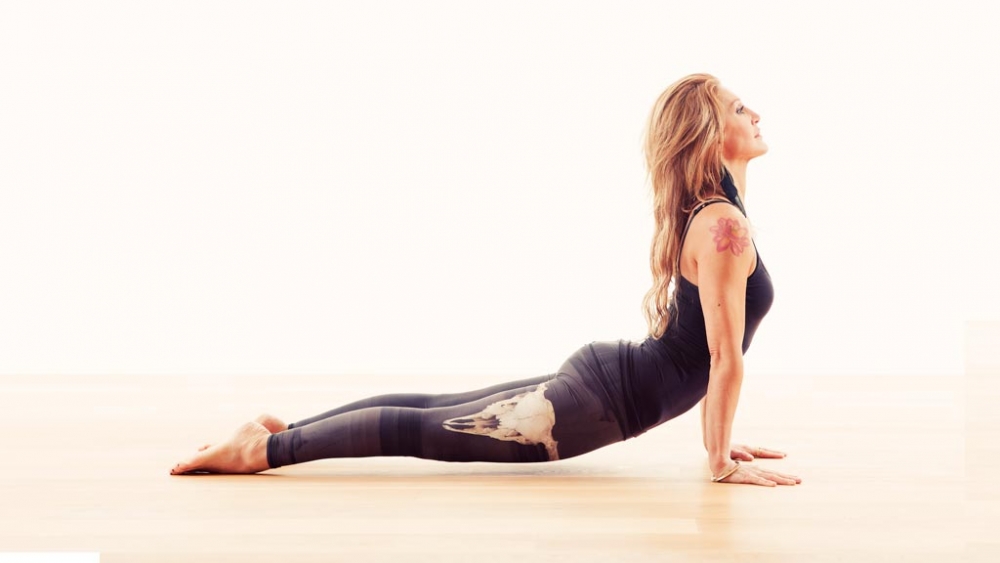Finding the balance between our stability/strength (Sthira) and flexibility/ease (Sukha) in a yoga pose is one of the most important aspects of our yoga practice. This applies not just to our physical practice but to our mental state and attitude as well.
In this article, we focus on flexibility and take a look at some of the factors that influence it.
Reciprocal inhibition
Muscles work in pairs – when one set is contracted (the agonists) the nervous system sends a message to the opposing muscles (the antagonists) to release.
Thinking about this in relation to a Standing Forward Bend/ Uttanasana the front of the body contracts as the back releases. By engaging the front of the thighs (quadriceps) we may gain more release in the hamstrings. However, if we strain to get into a pose it’s possible that we will start to tighten in areas that need to be released. It’s worth thinking about this before coming into a pose you may have some physical or mental resistance to – are you holding on to tension in other areas of your body? Your jaw perhaps or shoulders?
Muscles and the nervous system
Muscles spindles are tiny fibres which are embedded within our muscles. They set the tone (readiness to respond) of our muscles. Sensory nerve endings in the muscle wrap around these spindles and detect when they change shape. When sensors detect a stretch in the spindles which is greater or faster than it is used to, they send an SOS message through the nervous system telling the muscles to contract again. This is the stretch reflex.
So it is the change in shape of the spindles that communicates with our nervous system more than the change in length of the muscle itself.
In many cases our muscle spindles can be a little overprotective and so the message gets sent to our nervous system to contract the muscle to stop it lengthening well before our muscles have reached their full potential length.
Our muscle spindles have a range and speed of movement they are comfortable with based on the kinds of activities and repeated actions we do. As with anything to do with flexibility, this varies from person to person. For example, if someone regularly does an activity that requires high muscles tone – like a sprinter – the spindles will set their range to suit that type of quick-firing response.
The level at which the spindle and nerves react can change and adapt. The spindles can learn that it’s safe to let the muscle lengthen further than it is used to.
As we saw earlier, spindles react when they change shape greater or faster than their comfortable level so re-educating them needs to be a very gradual process involving both speed and range of motion. It is a process of taking the muscle slowly just up the point where the message would normally be sent to contract and holding there to let the spindle know it is a safe place to be. For example, you could be in a seated wide-legged forward bend and hold for 90 -120 seconds – making sure you are comfortable (using props if needed) so that you can breathe and hold the stretch. This is not a quick process but in this way we can gradually re-educate our nervous system allowing the safe working length of the muscle to increase.*
Connective tissues
In addition to our muscles and spindles, the properties of our connective tissues will also play a role in how flexible we are. Connective tissue such as tendons, ligaments and fascia are made up of different proportions of four components: Ground Substance, Collagen Fibres, Reticulin (another form of collagen) and Elastin. The amounts of collagen and elastin will determine the flexibility and elasticity of the tissue. Different types of connective tissue have different amounts of these components. So for example, tendons and ligaments need to be fairly strong and stable, so they have less elastin and collagen than fascia, which needs to have a greater capacity for stretch. People vary in the amounts of elastin and collagen within their tissues so we all have a different starting point when it comes to flexibility. More flexibility is not necessarily the aim across all connective tissue – stretching ligaments too much can destabilise joints.
Skeletal Geometry
Another important factor that we need to consider is the shape of our bones and how are skeletons are arranged. For example, the shape of our pelvic bones and the way our thigh bones fit into them will have a great impact on how easy (or in some cases, possible) it is for us to do certain poses. For some great visual examples of this take a look at Paul and Suzee Grilley’s images of bones on their website and read Yoga Hip Openers where I talk about this in more depth.
So what can we take from this?
This is just a quick look at some of the factors involved in flexibility and there are many more. However, hopefully we can see that where it is possible to make changes in our bodies we must do this with patience, calmness and awareness.
With a regular practise of coming slowly into poses and helping to calm the nervous system with the breath we may over time see changes in our flexibility. This could be on a physical level of muscle and connective tissue, but may also be on a psychological level – acceptance of our bodies and where we are now!
*The main source for this section was Leslie Kaminoff and Amy Matthews’ excellent Yoga Anatomy Fundamentals course.

